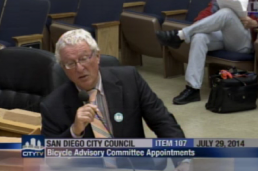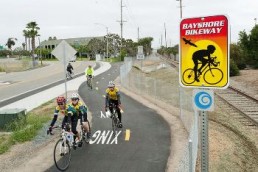San Diego City Council Adopts City's First Bicycle Advisory Committee
Earlier this week, on Tuesday, San Diego's City Council unanimously approved the creation of the city's first Bicycle Advisory Committee. This was a goal that was originally proposed in the 2002 city adopted bike plan, the city's second plan to accommodate bicycling.

Getting this committee established was one of our goals for our second year of existence (we launched as an organization in 2012). The composition of the committee calls for each Councilmember adopting one appointee and the two appointees made by the Mayor. Districts 4, 6, and 7 do not have a representative yet, so if you live in these neighborhoods now would be a nice time to get to know your elected representatives at City Council.
The current members of this new advisory committee include the following:
- Petr Krysl, involved with bicycling planning in UCSD where he is also a professor, representing District 1
- Nicole Burgess, who has been asking for improvements on Nimitz for as long as this website has been in existence, representing District 2
- Michael Brennan, the founder of San Diego Streets for People and a board member and a voice of reason at the Uptown Parking District representing District 3
- Kathleen Keehan, former executive director of the San Diego County Bicycle Coalition from 1999 to 2011, representing District 5
- Randy Van Vleck, Active Transportation Manager at the City Heights Community Development Corporation, representing District 9
- Andrew Hanshaw, current executive director of the San Diego County Bicycle Coalition and founder of Bike the Bay, representing District 3
- Kyle Heiskala, who led a successful student fee referendum at UCSD for bus and light rail access representing District 3
- and myself, Samantha Ollinger, representing District 8.
If you're not sure what all the District numbers mean, here is a link to a neat map that visually shows the entire city and its council districts.
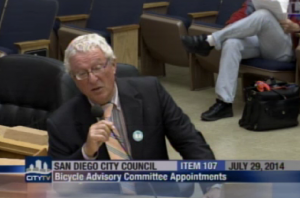
At the Council session on Tuesday, the item to approve the committee was scheduled to be on the consent agenda (essentially voted on without any discussion), however frequent Council Chambers visitor and occasional mayoral candidate, Steven Greenwald, asked for the item to taken out of consent and open for discussion. He was the only member of the public who spoke about the item and he spoke in support of it. He voiced support for "designated bike lanes" and asked that the city look to Vancouver for inspiration. He also talked up bike trains, which Nicole Burgess has been leading in Ocean Beach, and Veronica and Sandra have been leading in Mid-City. Greenwald also mentioned that not all drivers were "sensitive to the fact that bicycles have a place in transportation".
All councilmembers provided positive comments.
Marti Emerald (District 9) stated that perhaps even she could one day be on a bicycle, but that she was "petrified" to ride in traffic today.
Mark Kersey (District 5) thanked Kathy Keehan for her willingness to serve.
Sherri Lightner (District 1) thanked Petr Krysl for his willingness to serve.
Lorie Zapf (District 6 and soon to be District 2) thanked the entire group of committee members and recalled her experience of riding with Burgess and spoke about the needed changes to accommodate the upcoming bike share program as well and changes at Nimitz Boulevard and where the I-8 meets the dog park.
David Alvarez (District 8) spoke about the Climate Action Plan and commended the current District 2 staff that ride to their jobs at City Hall.
Ed Harris (interim Councilmember in District 2) seemed a bit surprised that the issue of bicycling had made a dent at City Hall and made generally positive comments as well.
Scott Sherman (District 7) spoke about the positive effects of seeing more people on bicycles.
Todd Gloria (District 3) stated that this was simply a formalization of the work that all of us had done to date. He also mentioned that the work done in the city to date were "modest" but wanted to see work sped up. Gloria also mentioned that the bike share program was scheduled to launch on October 30th this year. Gloria emphasized that this committee would be working with city staff to advise them on the work that needed to be done.
Emerald made a motion to approve the creation of the Bicycle Advisory Committee and newly re-elected Councilmember of District 2 (to be seated in November) Lorie Zapf seconded the motion.
A Nightmare in San Diego: The I-805 Project
The 2050 Regional Transportation Plan is supposed to be a vision for San Diego's future. The introduction of the RTP has gems like this:
The 2050 Regional Transportation Plan (RTP or the Plan) is the blueprint for a regional transportation system that further enhances our quality of life, promotes sustainability, and offers more mobility options for people and goods.
And this:
The Plan envisions most of these new jobs and homes situated in environmentally sustainable communities that are more conducive to walking and bicycling. They also will have more access to public transit.
Yet, the entire basis of the plan's implementation is based on improving (vehicular) Level of Service which is painfully evident if you review how the region is expected to look after the RTP's implementation in 2050 (pink arrows are my markings noting where funds will be expended to alleviate vehicle congestion). To recap, Level of Service measures vehicular delay at intersections.

One of the projects listed in the 2050 RTP is the I-805 project and we're going to take a good look at the northern section of this project: all 11 miles of it that is expected to cost $587 million. That is a cost of $53.36 million dollars per mile. This cost includes design and construction of the project (but not maintenance).
But what is the project going to deliver?
The project will widen the freeway to accommodate four carpool, or High Occupancy Vehicle (HOV), lanes from SR 52 to La Jolla Village Drive and two carpool lanes from La Jolla Village Drive to just north of Mira Mesa Boulevard.
Additionally, the project will construct Direct Access Ramps (DAR) at Nobel Drive and Carroll Canyon Road to allow commuters to easily access the carpool lanes.
At the southwest corner of I-805 and Nobel Drive, a Park & Ride lot will be constructed to encourage carpooling and to provide bus transfers from the proposed Bus Rapid Transit facility.
The project also reconfigures the Governor Drive interchange by relocating the southbound entrance-ramp to the northwest quadrant. This would minimize the conflict with southbound I-805 traffic getting on SR 52. Lastly, the project includes a direct freeway-to-freeway HOV connector in the median, from westbound SR 52 to northbound I-805 and southbound I-805 to eastbound SR 52.
Notice that the description makes no mention of how someone on foot or on bicycle is expected to navigate around this new monstrosity. As part of the environmental review process, the project considered three alternatives:
2. Transportation System Management (TSM) and Transportation Demand Management (TDM) Alternatives, or another way to say, "accommodating drivers and driving".
3. No build alternative, which was immediately dismissed because "it would be inconsistent with the purpose and need of this project"
And what is the purpose of this project?
The overall purpose of this project is to provide a backbone of multi-modal transportation facilities for the I-805 North project area while providing safe and efficient regional movement of people and goods through design year 2030.
Or to put it another way, "multi-modal" meaning absolutely the opposite of that.
SANDAG unveiled a video seven months ago to offer an explanation of sorts on what the I-805 North Project was about, as explained by Gustavo Dallarda, Caltrans I-805/I-15/SR78 Corridor Director:
In short, Dallarda doesn't understand the fundamentals of how to ease congestion. SANDAG who is funding the project simply assumes that the only way to solve San Diego's traffic congestion woes is to widen roads and build additional lanes instead of providing sustainable or environmentally proven and sound transportation options. Despite Dallarda's half nod to the project facilitating other modes of transportation besides the automobile - such as the Bus Rapid Transit that is scheduled to be built well after the automobiles have been accommodated - the project falls far short of any of the ideals described in the SANDAG RTP. And with the addition of even wider ramps that someone on a bicycle will have to navigate past speeding vehicles, what we're looking at is the creation of a San Diego neighborhood that is going to be extremely unpleasant to be in.
In other words, SANDAG is funding a project that is contrary to the trends in this country.
What would it take for SANDAG to learn that roads cause congestion, and that the building of more roads is only going to exacerbate the problem?

The I-805 North Project doesn't go into the detail of how unbelievably unfriendly the project currently is to experience on a human level, and how much worse it is going to be.
The construction of the project has been going on for a little over a year now and the construction has made the situation in Mira Mesa awful, as narrated by Elaine Litchfield in the videos below:
The I-805 North Project lists among its features all the widening that is going to take place.
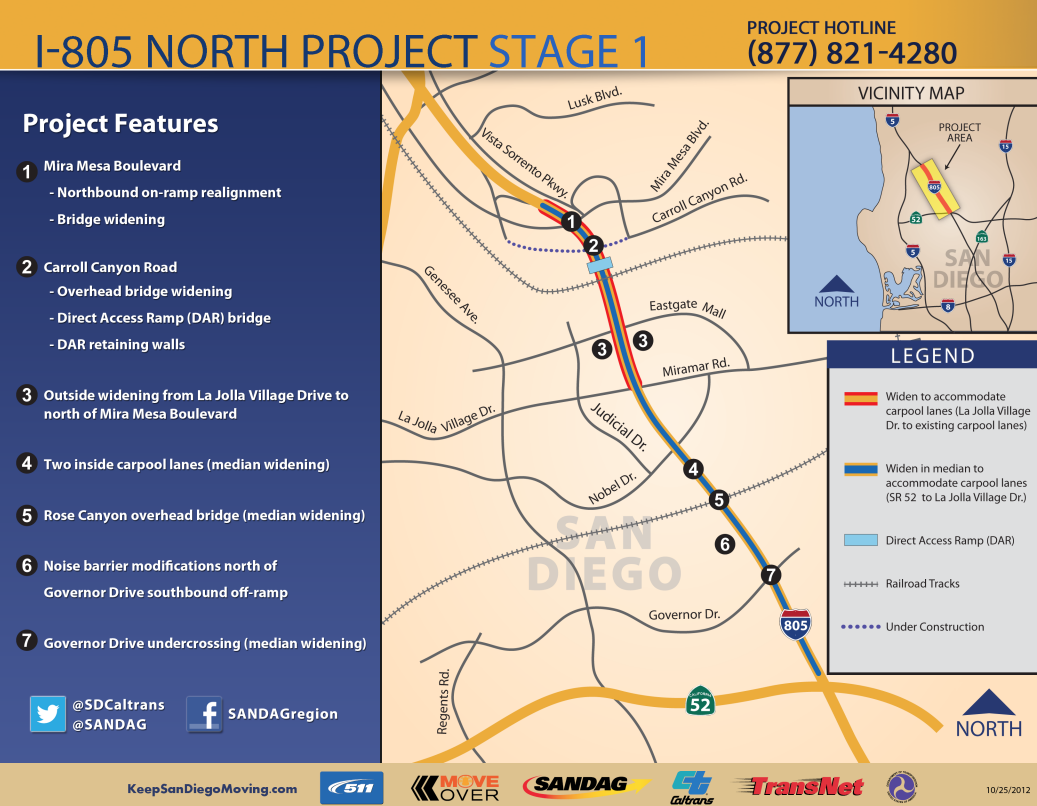
Litchfield and her husband live in Mira Mesa because she likes the neighborhood and her husband is able to take a BRT to his downtown job from a bus stop in front of their home. Her job is close enough that she can bike or walk to it - if it wasn't so terrifying.
When SANDAG began the visioning process for the RTP, the narrator explained that, "for the first time our planning efforts must focus on how to reduce greenhouse gas emissions."
Did SANDAG and the project's lead agency, Caltrans, really evaluate all options prior to deciding to go through with this project? How is expanding the road capacity for a 11 mile stretch to the tune of $587 million going to alleviate traffic congestion along the entire corridor? How is building this project going to make the community a place that residents will want to live in? Who is going to pay for the maintenance of this project and how will those funds be raised? And most importantly, how is this project sustainable or even vaguely environmentally friendly?
To provide perspective on how better these funds could have been spent, the city of Denver unveiled a 12.1 mile light rail line last April that was built using sales tax revenue and cost $707 million dollars.
Wouldn't a light rail be a better way to spend that $587 million to alleviate traffic congestion in San Diego?
$312 million updated Bike Plan passes with unanimous support from City Council

Last Monday, the update to the 2002 Bicycle Master Plan passed with unanimous support from the City Council. This plan to build an additional 595 miles of bicycle facilities nearly doubles the city's existing 510 miles* of facilities and further demonstrated our council's growing commitment to bicycling.
During public comment, two of our proposed requests were included in the motion made by Council Member (and current mayoral candidate) David Alvarez and amended by Council Member Sherri Lightner. Our request to create a Bicycle Advisory Committee to ensure the implementation of the plan was also supported by the San Diego County Bicycle Coalition (SDCBC). Our request to remove the Coastal Rail Trail alignments from Rose and Roselle Canyons was not supported by the SDCBC but was supported by the community that this alignment affected: the Friends of Rose Canyon, the University Community Planning Group and Council Member Lightner whose district includes University City. Council Member Lightner spoke to not only preserving the city's limited remaining open space but to also saving the city the huge financial and environmental expenses of building in Rose and Roselle Canyons - an amendment that was accepted by Alvarez and the rest of the council.

Melissa Garcia, Senior Planner at the City of San Diego, presented the item for council consideration by stating that the goal of the plan was to "create a city where bicycling is a choice." The goal to promote "environmental quality, public health and recreation and mobility benefits" were also mentioned. The purpose of the plan, Garcia stated, was to "maximize spending choices for implementation."
The original Bicycle Master Plan was adopted by the City Council over a decade ago in 2002. The update to the 2002 Bicycle Master Plan was prepared by Alta Planning + Design for the City of San Diego and begins with this promising statement in its introduction:
"...the updated plan provides direction for expanding the existing bikeway network, connecting gaps, addressing constrained areas, improving intersections, providing for greater local and regional connectivity, and encouraging more residents to bicycle more often."
Since 2002, most of the facilities built have been incredible and award-winning (such as the bike path around Lake Murray and Miramar Reservoir), but not effective in meeting the needs of everyday San Diegans by connecting neighborhoods to ensure daily riding in a way that is safe and comfortable. In the two years since the plan was updated, the plan went through respectable community feedback and input. Is the plan the best that it can be for current and future riders? The plan is incredibly promising and it should give everyone cause to celebrate. But a good plan alone will not transform our city. The important lesson from the last Monday's vote is that the political will is unanimous and the way forward is to ensure that this plan actually gets implemented with the efforts of a Bicycle Advisory Committee.

What will this committee do and who will it be composed of? That depends on what the City Attorney proposes to the City Council, but we'd like to have council staff, city staff, advocates and community members (including high school and college students) be active representatives. This committee will ensure that facilities get built and that the group doesn't become yet another layer of bureaucracy inhibiting the implementation of the bicycle plan. We'd like to see all facilities implemented with complete transparency.
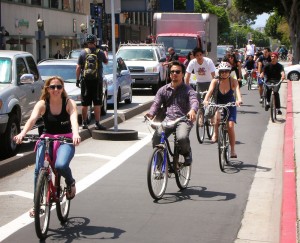
In this year alone, our council members have demonstrated incredible leadership. Interim Mayor Todd Gloria was the first to lead on the issue. Gloria has been very receptive to feedback, ideas, and has demonstrated a willingness to lead in a way that has not been seen before in San Diego. Council member and Land Use and Housing Chair Lorie Zapf's Council Resolution has provided us with much needed leverage to ensure accountability from the city staff in implementing bicycle infrastructure in the city. We have also learned how to listen to communities (such as the Friends of Rose Canyon) that seek us out and explain their concerns. Our success in transforming this city into a world-class city for bicycling depends on meeting the needs of our current ridership and being open and receptive to the feedback we receive from potential riders.
The next steps are not only to create the Bicycle Advisory Committee, but also to ensure that the plan is implemented. How will that happen? That will be the work for BikeSD's second year. Thank you for joining us on the ride.

---
Update on Year 1 Goals: Increasing City Funding for Bikes
When we launched last year, our board voted on a list of seven goals to help guide our advocacy efforts during our first year. We met many of our goals and are working towards or fine-tuning the remainder. We will provide a full update on how our first year transpired along with our annual report. Until then, I want to provide an update on our Goal #5:
Work to increase city funding for bikes from 0.1% of General Fund to 0.9% of General Fund to reflect existing bike mode share. Bike infrastructure, especially good quality bike infrastructure costs money and we’re going to advocate to increase funding in the City’s budget.
First, the good news: in this year's adopted budget, 3% of the city’s transportation budget will be spent on bikes.
Second, we need to dig deeper and learn more about what we uncovered.

Our board approved this goal last year based on the concept of induced demand. Induced demand also applies to bicycle facilities and within bike advocacy circles this translates into "build it and they will come".
In retrospect, the original goal as listed was a bit imprecise; for example, there was no need to base the amount off of the General Fund instead of the Transportation Department’s budget. However, this gave us an opportunity to learn about the complexity of bicycle facility funding.
In 2011, 0.9% of San Diegans (now 1.1%) were commuting by bicycle. We wanted to see a matching percentage of dedicated funding devoted to bicycle facilities and for that percentage to grow to facilitate bicycle ridership in the city.
We can see this correlation in other cities that have prioritized bicycling as a mode of transportation.
A more useful metric is per capita spending on bicycle facilities. We've been working towards the goal of $39 per capita to meet the Danish and Dutch funding reality. These two nations have figured out how to move nearly 50% of their population by bicycle in their largest cities.
What is being spent in San Diego?
In the city of San Diego a single bicycle facility can be built with funding from the city, the region (SANDAG), the state and/or the federal government. Tracking these numbers down has been a painful process, so we decided to start with the city.
Where does a tiny little organization even start? We started by making strategic alliances. In this case, I'm proud to state that we joined forces with the Center on Policy Initiatives (CPI) who created the Community Budget Alliance (CBA) - an alliance of over 40 organizations formed two years ago to advocate for a fair, equitable and transparent budget. When the former mayor released his draft budget earlier this year to the public for input, we worked with the CBA to dissect the budget.
Bicycle facilities can be both capital improvement projects (like the Mike Gotch bicycle/pedestrian bridge) or service-related projects (such as sharrows, bike route signs or the new buffered bike lanes being striped alongside the ongoing resurfacing efforts).
It's almost overwhelming to envision the facilities that need to be built in order to become a world-class bicycling city. However, in the last year we have focused on some of the deficiencies in the city, such as the deadly freeway on-ramps and off-ramps that are found in nearly every community. Freeway on-ramp redesigns would fall under the realm of a capital improvement project and since these facilities fall under the jurisdiction of two or more agencies (in this case, the city of San Diego and Caltrans), agency coordination is absolutely critical.
Through the training led by the CPI, we learned about the two categories of bicycle facilities: capital projects and service projects. But how much was the city spending on them? In April this year, I asked Corrine Wilson at CPI, who put me in touch with Nelson Hernandez, the city's Assistant Chief Operating Officer. I posed this question to him:
I was asked to contact you about getting some detail from the mayor's proposed budget. Since bicycle infrastructure comes under the umbrella of both capital improvement projects (assets) as well as service related projects - I find it an incredible challenge to break down what actually is being allocated toward bike projects in the city budget. Is there a way for you to send me that information and perhaps make it easier to find within the budget documents?
Hernandez directed me to the city’s Deputy Director of Transportation, Linda Marabian, who responded:
Sam, what I am familiar with and am working on is the CIP annual allocation projects I discussed at our last meeting regarding this issue. That is identified in the CIP Section of the budget.
This year’s budget lists both Capital Improvement Plans (CIPs) and service-related projects (including some staff funding) for a total of $1.109 million. This is a per capita spending of $1.17 or 3% of the total Transportation Department's budget. The projects listed in the budget were as follows:
- Minor bike facilities, $639,000: this includes sharrows, signs, bike lanes, and facilities that can be built based on traffic service requests.
- State Route 163/Clairemont Mesa Blvd Interchange, $350,000: The budget detail states that "[t]hese improvements will eliminate existing pedestrian/bike high-speed crossings and all vehicle, bike and pedestrian moves will be controlled, thus improving safety. Transit movement through the interchange will be area will be greatly enhanced."
- Bicycle Program Manager, $120,744: This position was held by Ed Clancy, but according to Marabian this position was "reabsorbed" into the department after Clancy's resignation. This council-approved position has been vacant for months and, despite our letter to Interim Mayor Gloria, has not been filled. We are at-risk of losing our hard-fought momentum.
With the elimination of Clancy's position, the city is spending $989,000 on bikes.
City funds are not the only funds that are used to build bicycle facilities. SANDAG also provides funds via Transnet. How much was SANDAG allocating to the city of San Diego?
While browsing the Independent Taxpayer Oversight Committee report on Transnet expenditures, I found that the city seemed to be sitting on about $54 million. Could these funds be spent on bicycle facilities? I asked Marabian how the city determined its Transnet spending priorities and she responded that Council Policy 800-14 determines the prioritization factor.
Understanding Council Policy 800-14
The CBA, as led by the talented individuals at CPI, has been working with councilmembers and city staff on updating Council Policy 800-14. The purpose of the policy (which was adopted by the council last night) is:
to guide the Mayor’s Capital Improvement Program Review and Advisory Committee (CIPRAC) in its CIP deliberations. The goal of this policy is to establish a capital-planning process that ultimately leads to policy decisions that optimize the use of available resources for projects competing from the same fund source or multiple fund sources.
When the draft policy was scheduled to be released at the council infrastructure subcommittee last month, we worked closely with CBA and city and council staff to ensure that our needs were addressed in the policy. The draft language on prioritization was excellent and had a few gems, including the following:
scoring projects higher that result in:
reduction in accidents, main breaks, sewer spills and flooding problems.promote community walk-ability and use of bicycles or public transit.
Our input had two main points: account for the fact that some assets can have multiple owners (such as the on-ramps mentioned above), and recognize that the biggest return on investment (especially for bicycle facilities) would be had in areas of high population density like the urban core communities in Mid-City.

Last night, our city council unanimously approved the policy (with Council President Gloria absent). Although we joined in at the tail end of updating this policy document we're glad to have been a part of this historic moment. The newly-strengthened council policy will ensure that our second year of advocacy will be more deliberate and informed by policies to strengthen our advocacy efforts.
Thank you to all our members who showed up in support!
Foto Friday: Buffered Bike Lanes on Mira Mesa Boulevard
Last month, Joe Punsalan noticed that buffered bike lanes had shown up on Mira Mesa Boulevard
Wha? Buffered bike lanes on Mira Mesa Blvd? Pinch me. @BikeSD Now just need the diagonal striping and we're good. pic.twitter.com/0Tjmr4awEZ
— Joe Punsalan (@joepunsalan) July 9, 2013
If the vehicle travel lane width was reduced with the implementation of this buffered bike lane, I hope the city is taking active steps to measure vehicle speeds and is considering reducing the speed limit from 50 mph. At 50 mph, unintentional driver errors could be deadly.
Steven Vance from Streetsblog Chicago thought that a concrete barrier to separate the bicycle traffic from the motor vehicle traffic could be a solution.
@joepunsalan @BikeSD You also need a concrete barrier
— Steven Vance (@stevevance) July 9, 2013
Perhaps Caltrans and the City could join forces and place a bulk order for Jersey Barriers.

